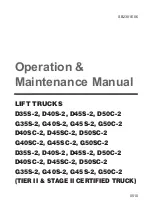
DESIGNATE A REPAIR AND ASSEMBLY
■
SUPERVISOR
Repairs and the mounting and dismounting of
attachments must be performed under the direction
of a designated supervisor. The body and major
parts of the lift truck are quite heavy and under very
high pressure. Repair or assembly work undertaken
without careful and thorough preparation can lead
to serious injury.
TRANSPORTING THE LIFT TRUCK
■
Use a level, hard road surface when loading the
truck onto or unloading from a trailer and when
unloading it. Be certain that the ramps have
sufficient length and width as well as strength.
Do not load or unload the truck when it is raining,
unless the ramps are fitted with an anti-slipping
surfaces.
It is safest to use a self-loading trailer truck
equipped with a jack and winch. For loading, tilt
the truck bed with the jack, attach the winch to
the towing pin of the lift truck, and pull it up. The
operator must not ride on the lift truck during
loading or unloading.
USE OPTIONAL “LIFTING EYES” FOR
■
LIFTING YOUR LIFT TRUCK
WARNING
Never hoist your lift truck at its overhead
guard or counterweight; otherwise there is a
danger of the truck falling.
If hoisting the lift truck is necessary for any
reason, use optional “Lifting Eyes.”
WARNING
Observe the following conditions when lifting
the lift truck:
Use optional “Lifting Eyes”.
•
Use ropes strong enough to withstand the
•
weight of the truck.
Do not use any wire rope which is kinked,
•
deformed or frayed.
Lifting the truck should be performed only
•
by qualified personnel.
Do not enter under a lifted truck.
•
LIFTING
EYES
1-12
FOR SUPERVISORS
TRANSPORTING THE LIFT TRUCK
Summary of Contents for FD20 Series
Page 51: ...MEMO...
Page 91: ...MEMO...
Page 139: ...MEMO...
Page 156: ...CONTENTS 0 9 6 2 A E 6 2 E L 6 3 L R 6 4 R U 6 5 6 1 6 INDEX...




































